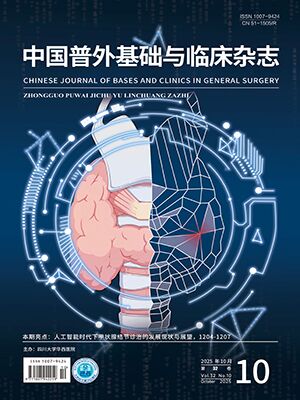| 1. |
Cai S, Qin C, Liu M, et al. Decoding lymph node skip metastasis: impact on long-term outcomes in stage T1 papillary thyroid carcinoma. Eur J Endocrinol, 2025, 192(3): 318-326.
|
| 2. |
Zhao L, Wu F, Zhou T, et al. Risk factors of skip lateral cervical lymph node metastasis in papillary thyroid carcinoma: a systematic review and meta-analysis. Endocrine, 2022, 75(2): 351-359.
|
| 3. |
延常姣, 黄美玲, 肖晶晶, 等. 甲状腺乳头状癌淋巴结跳跃性转移危险因素及分布特征分析. 中华普通外科杂志, 2024, 39(7): 544-549.
|
| 4. |
Nie X, Tan Z, Ge M. Skip metastasis in papillary thyroid carcinoma is difficult to predict in clinical practice. BMC Cancer, 2017, 17(1): 702. doi: 10.1186/s12885-017-3698-2.
|
| 5. |
Sant VR, Radhachandran A, Ivezic V, et al. From bench-to-bedside: how artificial intelligence is changing thyroid nodule diagnostics, a systematic review. J Clin Endocrinol Metab, 2024, 109(7): 1684-1693.
|
| 6. |
Li Q, Huang C, Zou H, et al. Single-center external validation and reconstruction of multiple predictive models for skip lateral lymph node metastasis in papillary thyroid carcinoma. Front Endocrinol (Lausanne). 2024, 15: 1366679. doi: 10.3389/fendo.2024.1366679.
|
| 7. |
Wang W, Yang Z, Ouyang Q. A nomogram to predict skip metastasis in papillary thyroid cancer. World J Surg Oncol, 2020, 18(1): 167. doi: 10.1186/s12957-020-01948-y.
|
| 8. |
Hu D, Lin H, Zeng X, et al. Risk factors for and prediction model of skip metastasis to lateral lymph nodes in papillary thyroid carcinoma. World J Surg, 2020, 44(5): 1498-1505.
|
| 9. |
Yang Z, Heng Y, Zhao Q, et al. A specific predicting model for screening skip metastasis from patients with negative central lymph nodes metastasis in papillary thyroid cancer. Front Endocrinol (Lausanne), 2021, 12: 743900. doi: 10.3389/fendo.2021.743900.
|
| 10. |
Zhao M, Shi X, Zou Z, et al. Predicting skip metastasis in lateral lymph nodes of papillary thyroid carcinoma based on clinical and ultrasound features. Front Endocrinol (Lausanne), 2023, 14: 1151505. doi: 10.3389/fendo.2023.1151505.
|
| 11. |
Jiwang L, Jinghui B, Fengqin F, et al. Comprehensive analysis of clinicopathologic and sonographic features in thyroid cancer with skip lymph node metastasis: establish and assessment of a prediction nomogram. Braz J Otorhinolaryngol, 2023, 89(5): 101301. doi: 10.1016/j.bjorl.2023.101301.
|
| 12. |
Yao X, Tang M, Lu M, et al. Interpretable machine learning models for predicting skip metastasis in cN0 papillary thyroid cancer based on clinicopathological and elastography radiomics features. Front Oncol, 2025, 14: 1457660. doi: 10.3389/fonc.2024.1457660.
|
| 13. |
Yang Z, Heng Y, Zhao Q, et al. The proposed modification of TNM staging and therapeutic strategy for skip metastasis in papillary thyroid carcinoma: a multicenter retrospective cohort study. Cancer Med, 2023, 12(12): 13270-13278.
|
| 14. |
Bertin JB, Buffet C, Leenhardt L, et al. Effect of skip metastasis to lateral neck lymph nodes on outcome of patients with papillary thyroid carcinoma. Langenbecks Arch Surg, 2022, 407(7): 3025-3030.
|
| 15. |
殷德涛, 赵乾. 全球及中国甲状腺癌的发病特征及趋势. 中国普外基础与临床杂志, 2025, 32(6): 687-693.
|
| 16. |
Zhao Y, Li W, Tao L, et al. Risk factors and nomogram to predict skip metastasis in papillary thyroid carcinoma. Gland Surg, 2024, 13(2): 178-188.
|
| 17. |
Zhu S, Wang Q, Zheng D, et al. A novel and effective model to predict skip metastasis in papillary thyroid carcinoma based on a support vector machine. Front Endocrinol (Lausanne), 2022, 13: 916121. doi: 10.3389/fendo.2022.916121.
|
| 18. |
Hou J, Zhang Y, Fan Y, et al. Risk factors of skip lateral lymph node metastasis in papillary thyroid carcinoma. Eur Arch Otorhinolaryngol, 2021, 278(2): 493-498.
|
| 19. |
Zhao W, Chen S, Hou X, et al. Predictive factors of lateral lymph node metastasis in papillary thyroid microcarcinoma. Pathol Oncol Res, 2019, 25(3): 1245-1251.
|
| 20. |
Shao L, Wang Z, Dong W, et al. Risk factors associated with preferential lateral lymph node metastasis in papillary thyroid carcinoma. Cancer Med, 2023, 12(22): 20670-20676.
|
| 21. |
Ryu YJ, Kwon SY, Lim SY, et al. Predictive factors for skip lymph node metastasis and their implication on recurrence in papillary thyroid carcinoma. Biomedicines, 2022, 10(1): 179. doi: 10.3390/biomedicines10010179.
|
| 22. |
Zhang X, Chen Y, Chen W, et al. Combining clinicopathologic and ultrasonic features for predicting skip metastasis of lateral lymph nodes in papillary thyroid carcinoma. Cancer Manag Res, 2023, 15: 1297-1306.
|
| 23. |
Weng HY, Yan T, Qiu WW, et al. The prognosis of skip metastasis in papillary thyroid microcarcinoma is better than that of continuous metastasis. J Clin Endocrinol Metab, 2022, 107(6): 1589-1598.
|
| 24. |
Özden S, Çomçalı B, Ataş H, et al. A diagnostic dilemma: skip metastasis in papillary thyroid cancer. Am Surg, 2020, 86(3): 245-249.
|
| 25. |
Feng JW, Qin AC, Ye J, et al. Predictive factors for lateral lymph node metastasis and skip metastasis in papillary thyroid carcinoma. Endocr Pathol, 2020, 31(1): 67-76.
|
| 26. |
Zhao H, Huang T, Li H. Risk factors for skip metastasis and lateral lymph node metastasis of papillary thyroid cancer. Surgery, 2019, 166(1): 55-60.
|
| 27. |
Jin WX, Jin YX, Ye DR, et al. Predictive factors of skip metastasis in papillary thyroid cancer. Med Sci Monit, 2018, 24: 2744-2749.
|
| 28. |
战欣, 薛帅, 殷悦, 等. 乳头状甲状腺癌颈部淋巴结跳跃性转移的因素分析. 中华外科杂志, 2017, 55(8): 599-602.
|
| 29. |
Lei J, Zhong J, Jiang K, et al. Skip lateral lymph node metastasis leaping over the central neck compartment in papillary thyroid carcinoma. Oncotarget, 2017, 8(16): 27022-27033.
|
| 30. |
Park JH, Lee YS, Kim BW, et al. Skip lateral neck node metastases in papillary thyroid carcinoma. World J Surg, 2012, 36(4): 743-747.
|
| 31. |
Sui C, He Q, Du R, et al. Lymph node characteristics of 6 279 N1 differentiated thyroid cancer patients. Endocr Connect, 2020, 9(3): 201-210.
|
| 32. |
王帅, 于耀程, 尉志伟, 等. 基于机器学习构建甲状腺乳头状癌淋巴结跳跃性转移的预测模型. 中国肿瘤外科杂志, 2024, 16(4): 324-329.
|




